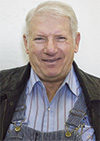If the haul rate was quoted based on one ton per bale, the trucker ended up with a fully loaded truck and three-quarters of a load’s pay.
You can bet your bottom dollar the trucker expressed his displeasure with the situation to the end user of the big bales in language the dairymen and other users could understand.
“Yes, they are easier to handle, but they can never get the quality in a big bale that you can in a small bale. The hay has to be powder dry or the inside will burn up. All the leaves are left in the field; there cannot be much milk in that kind of hay,” is what was being told to the dairymen.
Some growers would buy a big baler or two just to use in weather disaster situations. A big baler will bale faster and cheaper than small balers will, and if thoroughly rained on hay is what the grower is dealing with, no matter what was done with it, it was only cheap feeder hay at best. So why do you want to spend the extra time and money to small bale what will be “give-away priced” feeder hay?
The other weather disaster that brought the big balers into play was several windy nights in a row with no dew to stick the leaves to the stems while baling.
While the big baler left a lot of leaves in the field when baling tinder-dry hay, it got more of the leaves in the bales than did the small balers.
Again, the situation was that the hay had to be removed from the field to avoid ruining the next crop; and if, no matter what was done, it was going to be too dry for the premium dairy market, then it made sense to use the big balers again.
As the dairy and feedlot industries evolved to using totally mechanized forage handling equipment, the use of the big baler also changed.
I think the change happened by someone noticing that occasionally a few big bales would show up with decent leaf retention. The other accident, or miracle, was that the center of those “very nice” bales was not moldy.
Not even tobacco brown. A little homework on the part of the hay growers and hay buyers found the cause of the very nice bales in the stack of “too dry” feeder hay.
After waiting too many days for a night with dew for baling up what should have been premium dairy hay, the decision had been made to bring in the big balers.
By this time the baling part of the haying operation was way behind the swathers and rakes. With the emphasis on “hurry”, the big balers started as early in the morning as the growers dared let them without fear of haystack fires from hay baled too wet.
The big balers ran all day, only stopping when the growers feared problems from hay baled too wet.
Now consider the moisture in the hay at baling. The hay being discussed here has been lying in the field so long that the stem of the alfalfa has completely dried out.
Even though there has not been enough dew to make an acceptable product with small balers, at dawn there is enough “toughness” from a very light dew or from ground moisture to hold the leaves with the stems as the big baler picks up the windrow of hay.
Much more gently than a small baler, it folds the hay together and compresses it into a bale. The same situation occurs as dusk falls, with just enough moisture added to make a very nice product.
The smart dairyman has always been willing to pay more money for better hay. As the hay growers learned how to use the big balers, they became able to produce a product that “milked” the same as premium small bales.
This became a win-win situation. The dairyman has quality forage that can be totally mechanically handled, and the hay grower saves a bundle on labor costs since one big baler will equal five to seven small balers in tonnage baled in the same time.
With the 3-by-4-foot big balers, it gets even better since a 1,200- to 1,300-pound, 3-by-4-foot big bale is fairly easy to produce. This makes the truckers happy, since a normal load of 3-by-4-foot bales will make a full payload on a hay truck.
The other plus for the 3-by-4-foot bale size is that they seem to tolerate a bit more moisture at baling, as long as that moisture is dew moisture and not stem moisture.
The feeding mechanism on the 3-by-4-foot balers are different enough from the 4-by-4-foot balers so the hay is disturbed less as it moves from the windrow into the bale chamber. This makes nicer looking hay.
Enter the export market. The dairymen of the Far East are not far behind the domestic dairymen. They also want nice hay that milks well. As the Japanese dairy industry has matured, there are a number of larger operations that want the convenience of handling forages mechanically.
Yes, this means big bales are being exported. The other situation rapidly becoming commonplace is cutting big bales down into the dimensions of the traditional export-sized bale and double compressing the hay.
This hay that starts out as big bales is ending up in the Far East in two-tie and “half-cut” size. (The regular “half-cut” is made by double compressing a three-tie bale from 16 inches by 23 inches by 48 inches to 16 inches by 23 inches by 22 inches, and then cutting it in half to a nominal size of 16 inches by 11.5 inches by 22 inches.)
Hay put up in big bales, particularly the 3-by-4-foot bale, can equal or exceed the quality of small bales when put up with equal attention to moisture at baling time. Of course, no matter what you do, you cannot harvest alfalfa too mature and have a quality product.
One fellow locally was having a bad day a few years back. Trying to cheer him up, I said this balances out the good days. He shot back that every day can be a good day.
Keep that in mind when operating big balers. Every bale can be a premium bale. It is all in the mindset of the hay grower or custom operator. Your baler header and your rakes must still be set to pick up just the hay. Just the hay from this crop. After too dry and too mature, dirt in the hay is the big disqualifier for hay being exported.
We still hear back from Japan that occasionally one of the inspectors will lay a white sheet down and break and scatter three or four bales of hay on it.
He will then shake the hay thoroughly and then remove the hay from the sheet. If there remains half a thimble full of what appears to be dirt on the sheet, guess what? The whole shipment is rejected and sent back to the United States. Just in case you were wondering, the domestic dairymen and feedlot operators are not happy with dusty, dirty hay either.
In a nutshell, keep it clean, green, tender, and preserve the leaf. FG













